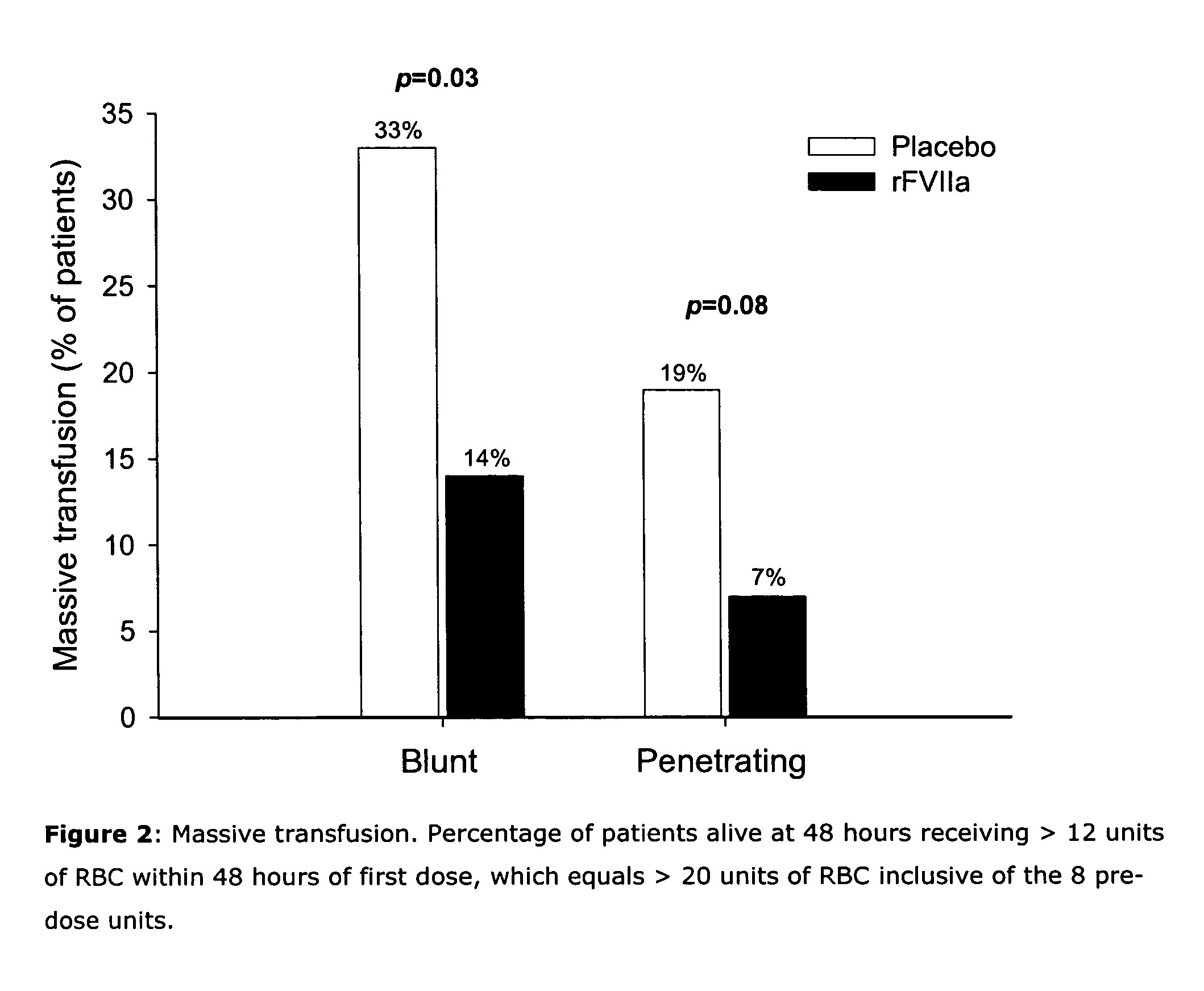Uses of factor VIIa or factor VIIa equivalents for treating late complications of trauma
a technology of factor viii and trauma, which is applied in the direction of drug compositions, peptide/protein ingredients, extracellular fluid disorder, etc., can solve problems such as bleeding arrest, and achieve the effects of reducing the risk of developing disseminated intravascular coagulation (dic), reducing the risk of progression, and reducing the risk of bleeding
- Summary
- Abstract
- Description
- Claims
- Application Information
AI Technical Summary
Benefits of technology
Problems solved by technology
Method used
Image
Examples
example 1
Factor VIIa Administration to Trauma Victims
[0110] The following study was performed in order to assess efficacy and safety of recombinant activated coagulation factor VII (rFVIIa, NovoSeven®) as adjunctive therapy for bleeding control in severe trauma
Methods
[0111] A multicenter, randomized, double-blind trial compared rFVIIa with placebo. Study product was administered as 3 i.v. injections (200, 100 and 100 μg / kg) at time 0, 1 and 3 h after transfusion of 8 units of red blood cells (RBC). Patients were monitored for 48 hours after dosing with 30-day follow-up. Standard local hospital treatment was given throughout. Blunt and penetrating groups were separately analysed.
Results
[0112] In total, 143 blunt and 134 penetrating patients were analyzed. In patients with blunt trauma (Injury Severity Score mean ±SD: 33±13), there was a trend to decreased RBC transfusion within 48 h of dosing (primary endpoint) in the rFVIIa group vs placebo when adjusting for patients who died within ...
example 2
Efficacy of Factor VIIa Given in Conjunction with Standard Therapy in the Treatment of Trauma
Trial Design:
[0114] A multi-centre, randomised, double-blind, parallel group, placebo-controlled trial was conducted in subjects with severe blunt and / or penetrating trauma injuries. Subjects were recruited for screening upon admittance to the trauma centre. In conjunction with the trial product, they received standard treatments for injuries and bleeding and any other procedures deemed necessary by the physician in charge of coordinating the trauma team. The trial is comprised of two treatments arms. Eligible subjects, upon receiving 6 units of PRBC within a 4-hour period, will be equally allocated to one of the following arms: [0115] Standard therapy in conjunction with three single doses (volume equal to 200 μg / kg+100 μg / kg+100 μg / kg) of placebo administered over a 3 hour period [0116] Standard therapy in conjunction with three single doses (200 μg / kg+100 μg / kg+100 μg / kg) of rFVIIa adm...
example 3
In Vitro Evaluation of the Impact of Colloid Hemodilution, Acidosis, and Hypothermia on the Effect of Recombinant Factor VIIa
[0212] The following experiments were performed to assess the effect on clot formation of Factor VIIa under physiological conditions that are clinically relevant in trauma, ie., low pH (acidosis), low temperature (hypothermia), and colloid hemodilution.
1. Methods
[0213] Blood Collection: WB was obtained using a 21-gauge needle from six healthy volunteers. Samples were drawn into tubes containing citrate, mixing one part of citrate with nine parts of blood. The first tube of collected blood from each participant was discarded. After the blood samples had rested for 30 minutes at room temperature, they were manipulated to mimic one specific clinical situation, as outlined below.
[0214] To stimulate acidosis, WB (2 mL) was made acidic (pH 7) by the addition of 140 μL of N-2-hydroxyethylpiperazine-N′-2-ethanesulfonic acid (HEPES) 1 M buffer, adjusted to pH 7. T...
PUM
| Property | Measurement | Unit |
|---|---|---|
| Time | aaaaa | aaaaa |
| Time | aaaaa | aaaaa |
| Dimensionless property | aaaaa | aaaaa |
Abstract
Description
Claims
Application Information
 Login to View More
Login to View More - R&D
- Intellectual Property
- Life Sciences
- Materials
- Tech Scout
- Unparalleled Data Quality
- Higher Quality Content
- 60% Fewer Hallucinations
Browse by: Latest US Patents, China's latest patents, Technical Efficacy Thesaurus, Application Domain, Technology Topic, Popular Technical Reports.
© 2025 PatSnap. All rights reserved.Legal|Privacy policy|Modern Slavery Act Transparency Statement|Sitemap|About US| Contact US: help@patsnap.com



